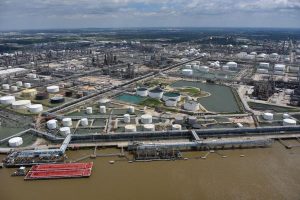In the wake of Hurricane Harvey, the average price of a gallon of gasoline nationwide spiked by 25 cents, with some states seeing an increase of as much as 42 cents per gallon. This is the largest increase in a single week since the 49-cent jump following Hurricane Katrina in 2005. The fact that the entire nation’s fuel infrastructure can be disrupted by a localized single event is deeply concerning. In fact, our economy is disproportionately reliant on oil —10 of the previous 11 U.S recessions were preceded by a spike in oil prices (and subsequently gasoline). Indeed, as Michael E. Webber, deputy director of the Energy Institute at the University of Texas at Austin noted: “The hurricane did what terrorists could only dream of and [took] a third of U.S. refinery capacity off line for days on end.”

Photo by PO1 Patrick Kelley/U.S. Coast Guard/UPI
This begs the question: What can the U.S. do to reduce its vulnerability to the threat posed by future natural disasters, terrorist attacks, or other events that could cause gasoline prices to spike? Environmental groups such as the NRDC advocate for increased vehicle efficiency, a transition to electric vehicles, and smart infrastructure planning. Meanwhile industry groups like API champion expanding and improving our domestic energy production and fuel infrastructure. With the exception of a widespread transition to electric vehicles—something that is still decades away—neither approach solves the problem, which is our overwhelming dependence on a single commodity.
To truly reduce our vulnerability, we need an open market where drivers have access to multiple fuels. This reality could be achieved by easing barriers to entry in the fuels market and promoting vehicles that operate on multiple fuels. The means to achieve this objective already exist. Today, there are 26.8 million alternative fuel vehicles on the road in the United States, the majority of which are flex-fuel vehicles that can run on both gasoline and ethanol. Additionally, the Department of Energy’s Co-Optima program is already working to find ideal alternative fuels and integrate them with advanced engine technology and then into the marketplace. However, given that 88% of the energy used in the transportation sector comes from oil-derived fuels, we still have a long way to go.
The irony of the oil capital being hit by a storm fueled by higher than normal ocean temperatures and an atmosphere holding more water vapor due to increased global temperatures… Read more »
“The irony of the oil capital being hit by a storm fueled by higher than normal ocean temperatures and an atmosphere holding more water vapor due to increased global temperatures… Read more »
I agree with Dan and would like to add some new projections numbers … I think many have not realized how fast the long view is changing and not many… Read more »
Hi Jane, It’s true EV projections are increasing, but all of the ones you listed—even the most optimistic among them—would see hundreds of millions, if not still billions of gasoline/diesel… Read more »
Your point is well taken Nathan …but beware of looking primarily at the US. Turns out we are at the bottom of adiption lists. …. “China is positioning itself far… Read more »
The prediction comes from Tony Seba, author of Clean Disruption of Energy and Transportation: How Silicon Valley Will Make Oil, Nuclear, Natural Gas, Coal, Electric Utilities and Conventional Cars Obsolete… Read more »
Thank you Dan, very interesting.
Far from revealing any vulnerability of our fueling infrastructure, Harvey has shown how resilient the oil and gas distribution system is and how well the market works to bring in… Read more »
Interesting, but I’m not sure you addressed my main point, which is that because consumers don’t have another option other than gasoline/diesel they’re forced to pay more for their fuel,… Read more »
Nathan: Americans already pay an artificially low price for fuel since the price does not include the real external costs of using such fuels such as stronger and more damaging… Read more »
I think the solution is going to be addressed in the Tech Economy of the future. EV Uber or some version. Most people who live in the city are giving… Read more »
Nathan: If one of your replies above you say “Shouldn’t we be game planning for that and have other alternatives like biofuels, hydrogen, and natural gas available to speed our… Read more »
Dan, The analysis of hydrogen vehicles by Joe Romm that you reference may be out of date. A recent article (https://www.pv-magazine.com/2017/08/30/future-pv-the-feasibility-of-solar-powered-hydrogen-production/) by Norway’s Nel Hydrogen states that they use electrolyzers… Read more »
Henry: I don’t think Joe’s articles are out of date. While is certainly possible to generate “clean” hydrogen using renewables, most hydrogen comes from natural gas reforming. But even if… Read more »
This issue was debated in great depth by the IEEE Energy Policy Committee, and by others in the professional engineering community we worked with. See http://www.werbos.com/E/TransPolicy 2006-29-15 PJW markup july… Read more »
And oops — a vital obvious point: OF COURSE a rational market would include “externality payments” in principle, to reflect the value to national security. That applies both to alternate… Read more »
Actually, what Harvey exposed was the downside of Houston’s adversion to zoning and any type of land use controls. As far as the impact on the oil and gas industry,… Read more »